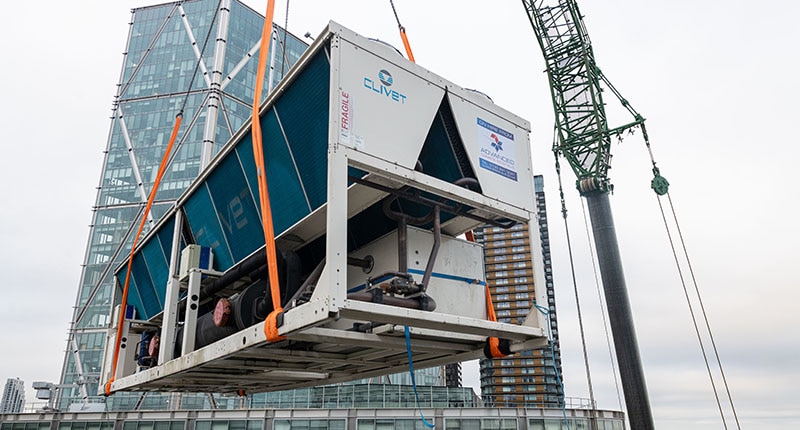In accordance with transitioning our portfolio to be net zero by 2030, British Land is optimising our buildings’ equipment for efficiency and comfort, and eliminating fossil fuels from the energy mix. Here, we look at the power of air source pumps to accelerate progress on climate goals and improve UK workplaces.
Air source pump technology uses outside air to heat and cool buildings. The benefits of shifting from traditional gas boilers to air source heating include substantially lower carbon emissions, dramatically improved energy efficiency and reduced energy bills for customers – ensuring comfort levels are optimised for productivity and wellbeing.
Through our most recent installations, we’ve transitioned our own head office, York House, and 199 Bishopsgate, Broadgate, to become fully electric – positioning these assets to benefit from grid decarbonisation in the coming years.
On earlier installations, we kept an element of gas, as the technology was not as advanced and to guarantee performance for customers whilst it was thoroughly tested; today’s pumps generate greater heating and cooling than earlier options.
Supporting customers’ goals
Engaging with customers in diverse sectors – including finance, law, media and tech – we’ve experienced more support of our plans to transition their workspaces to net zero, as this aligns with their own goals.
In buildings where we’re going fully electric, we’re also collaborating with customers to complete deep reviews of air handling units and fan coil units on their floors, to make sure that the new systems run smoothly everywhere, from day one.
Getting the timing right
Air source heating and cooling is an important part of the net zero pathways we’ve developed for all our campus buildings. We always time retrofits for an appropriate point in the lifecycle replacement; otherwise, they’re costly from a financial and carbon perspective. We therefore overlay our net zero pathways and lifecycle replacement plans, considering the age, condition and reliability of existing equipment, alongside the embodied and operational carbon impacts of replacements.
A recipe for success
Retrofitting air source heating is more complex than like-for-like boiler replacements, but the benefits make it worthwhile. For those embarking on their journey, our recipe for success includes:
- Understand your building.
- Know the latest technologies.
- Choose the right equipment.
- Engage with customers.
- Work closely with the manufacturer.
- Implement a robust control strategy.
- Commission the system effectively.
- Implement continuous monitoring and optimisation.
The year following an air source pump installation, we bring the whole project team back together every quarter to fine-tune seasonal controls and identify optimisation opportunities. The team includes the manufacturer, main contractor, design consultant, building engineers, M&E team, BMS partner and anyone else who interacts with the equipment. We have good data on the business case for air source pumps, and every project learns from previous projects to continuously improve.
Moving fast
When we installed our first air source pump at 350 Euston Road in 2014, it was the largest retrofit of its kind in the UK. This influenced the mainstream engineering world, paving the way for air source heating as a viable, low carbon alternative to traditional gas boilers in the UK’s commercial buildings. We’ve engaged with approximately 30 customers and partners since, to roll out nearly 20 air source pumps across our campuses.
Today, we consider the technology as standard and are keeping our eyes open for new solutions.
We welcome conversations with customers who are keen to achieve climate goals. Together, we can accelerate progress.
Contact: sustainability@britishland.com


